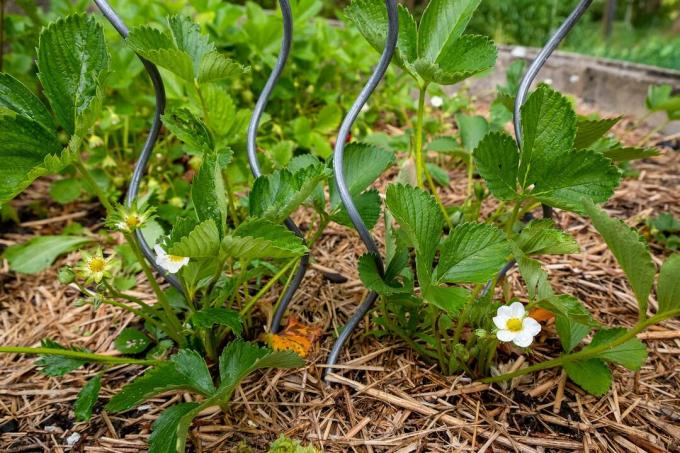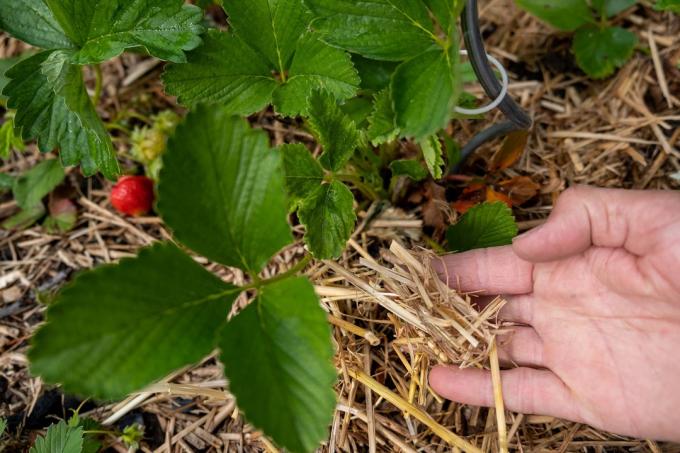
The easy-care climbing strawberry Hummi® is a popular strawberry variety because the fruits are particularly aromatic and sweet. The article explains what the ideal care and overwintering for a rich harvest over many years looks like.
We always refer to them Hummi®, but do without the ® in the further course of the text for the sake of readability.
In a nutshell
- long strong tendrils must be supported
- less susceptible to rot than other strawberry varieties
- optimal location sunny and protected from wind and weather
- Can be cultivated both in beds and in tubs
- Climbing strawberries need a lot of water and nutrients
Table of contents
- location and soil conditions
- watering and fertilizing
- Cut
- hibernate
- frequently asked Questions
location and soil conditions
Caring for the Hummi climbing strawberry is not very difficult, as it does not require much for its healthy growth and a bountiful harvest. Nevertheless, they should receive a little care. First and foremost, this includes the right location and the ideal substrate. The location should be sunny, but also protected from wind and weather. Since you can cultivate the strawberries both in the tub and in the bed, a sunny, covered balcony or terrace is a very good location:
- Ideally, always choose a location under a small eaves
- in the garden bed in a corner in front of a southern wall
- In a pot on a south facing wall
- this avoids too much moisture from above
- soil in the garden bed prepare with compost
- mix in sand or gravel for heavy soil
- Substrate ideally humic, nutritious and well drained
- always create drainage for tub culture
- use soil that is ready in the pot for berry plants

Tip: Always place the pots with the strawberries high enough or use them as garden beds raised bed. Because the unpleasant ones slugs prefer the strawberries. Cultivate the plants increased, make it difficult for the snails.
watering and fertilizing
In order for the harvest to be successful and the strawberries to be able to produce new flowers and fruits over the summer, ideal care must also be taken when watering and fertilizing. Because you can not only harvest strawberries once in summer, but depending on the climate area even into October:
- regular watering required
- Soil should always be slightly moist
- Climbing strawberries have high nutritional requirements
- supply regularly with liquid berry fertilizer
- pay attention to a high potassium content
- this is important for hibernation
- last fertilization after the last harvest
- first fertilization in late winter before budding
A notice: Even if the soil should always be slightly damp, it is important to ensure that there is no waterlogging, especially with potted plants. It is therefore helpful if you pour off the drip tray about half an hour after watering.
Cut
So that the Hummi climbing strawberry bears lots of fruit and the harvest is bountiful, the right cut is crucial when caring for it. In the first year after planting in spring, you should therefore cut off or break off the first flowers by the end of May:
- This promotes climbing of the young plants
- next flowering will be significantly more and stronger
- this way a higher yield can be achieved
- also cut the first foothills in spring
- Cut off shoots and tendrils that have become too long
- take away the power of the strawberry plant to form flowers
- cut off all runners and tendrils in autumn
- last cut after the last harvest
- before the first frost at the latest
- Prepare the plant for wintering

Tip: If the climbing strawberries were planted in autumn, then they were already able to grow well. In this case, and also with older plants after wintering, it is not necessary to remove the first flowers.
hibernate
Even if the Hummi climbing strawberries are considered hardy, protection against severe frost is still recommended when caring for them. After you have removed all tendrils from the plant and only the actual mother plant is left, you should take further measures for the Hibernation outdoors make.

Measures
- cover plants cultivated in the bed with litter, leaves or mulch
- Heart bud should be covered
- Place pots in a sheltered, shady spot
- for example in a balcony or terrace corner
- Wrap buckets with fleece or brushwood
- also cover plants here
- alternatively, the pot can also overwinter indoors
- put in cool and bright room
- when wintering indoors, it needs to be watered from time to time
- The strawberry plants are not fertilized in winter
frequently asked Questions
The propagation of strawberries is relatively easy. Because the plants form long tendrils, which can be used as sinkers. In this way, the tendrils are brought into contact with the soil in the bed at one point. As an alternative to pot culture, a small seed pot with soil is placed directly next to the mother plant. A small, curved nail stuck into the ground above the sinker can provide support here. Then take care of the strawberries as usual and wait until a new small plant has formed, then the tendril can be separated from the mother plant.
Like all other strawberry varieties, climbing strawberries can also be affected by white spot disease and Verticillium wilt. In both cases, a fungus is the cause. If it is too wet between June and August, vitiligo can occur. It is therefore advisable to cover the soil of the garden beds with brushwood or mulch in very rainy months. Verticillum wilt, on the other hand, occurs in the opposite, i.e. very long, hot and dry phase. To avoid the spread of this fungus, the soil must be replaced altogether.
So that the fruits do not rot, they must not come into contact with the earth. Because this is kept permanently moist, this moisture is quickly transferred to the strawberries, which then begin to rot. A layer of brushwood can help here. Climbing strawberries should also always be given a climbing aid, as these are not climbing plants that can hold themselves up. In addition, a location should be avoided where the strawberries are exposed to a lot of rain.
Since the Hummi climbing strawberry is not actually a climbing plant, it always needs one climbing aid, to which the tendrils must also be attached. In addition to the well-known trellis, a trellis or trellis are also suitable here. You can use climbing spirals for plants grown in pots. A garden bed directly in front of a garden fence is also a good solution. The climbing aids should always be about 150 centimeters high.



